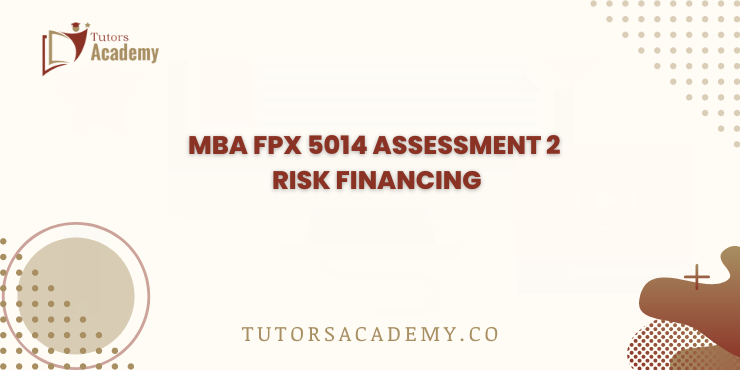
- MBA FPX 5014 Assessment 2 Risk Financing
Risk Financing
Date:
To: XYZ
From: Risk Manager
This memo aims to facilitate a discussion with the members of the XYZ team on the issue of risk financing related to the problem of high HACs. Currently, the XYZ of Pittsburgh has a strong culture of safety, enhancing its impact on nursing care quality and favorable outcomes. However, the new incidence rate of HACs that has been determined at the healthcare institution (UPMC XYZ Hospital of Pittsburgh, 2021) is tied to ADEs.
This is linked to such poor quality of care and high readmission rates, which attract penalties from Medicare or low per-patient reimbursements from CMS (CMS, 2024). Revenue-capitation payment, together with high WACs and readmission, can cause worse reimbursement compared to expenses at the XYZ Hospital of Pittsburgh (UPMC XYZ Hospital of Pittsburgh, 2021). Hence, this issue becomes foundational to risk management and financing for the XYZ Hospital of Pittsburgh, which is an ACO.
Regulations of the ACOs in the United States (US) include the sharing of reimbursement, patients with membership, and compliance with regulatory requirements on HAC and readmission rates of the ACA and CMS guidelines (CMS, 2024). ACHE’s nine code of ethics states the ethical risk obligations of the ACOs as follows: public responsibility and reporting, health care protection, which entails taking steps to prevent harm to the patients such as HACs (ACHE, 2022).
Therefore, the XYZ Hospital of Pittsburgh is required to make effective decisions to decrease HACs and enhance patient safety as a legal and ethical responsibility of an ACO, as identified by Woods in 2024. Lack of reasonable care quality and patient safety results in low reimbursement and penalties since CMS has the legal right to act against XYZ Hospital of Pittsburgh (CMS, 2024).
MBA FPX 5014 Assessment 2 Risk Financing
Fat unusual risk management issue of high ADEs at the XYZ Hospital of Pittsburgh has been effectively discussed using two strategies. First, it examined the ADE and patient safety widgets on the dashboard to compare the growth of HACs. Secondly, the application of the operational excellence tool known as the DMAIC model stands for Define, Measure, Analyze, Improve, and Control. Therefore, according to the identified model, the problem was the high rate of ADEs that were determined via the dashboard metrics as described above (Agley et al., 2021).
In the third step concerning the subject, options for improving the provision of healthcare with low rates of ADEs as HACs were investigated. The suggested solutions were to train the nurses to familiarize themselves with the healthcare technology and, secondly, to focus on the Clinical Decision Support System (CDSS) that is to be imposed during the fourth stage of the DMAIC approach to substantiate the issue (Maddox et al., 2022).
Thus, the primary strategy of implementing the above methods in XYZ Hospital of Pittsburgh has been reserved for monitoring, which is carried out with the help of a dashboard in the form of metrics at the final step. The major problem affecting these strategies is the reluctance displayed by nurses to embrace them.
The first recommendation is linked to the actual use of CDSS at the XYZ Hospital of Pittsburgh. Maddox et al. (2022) found that the application of CDSS helped decrease ADEs connected with HACs. The second recommendation was to increase the efficiency of the training process for the nurses’ further proper application of technologies when present at XYZ Hospital of Pittsburgh.
The data provided evidence of the decreased ADE occurrence after adequate training for the nurses in the use of healthcare technology (Ali et al., 2021). Thus, the problem of low payment can be solved through the implementation of these suggestions to optimize HACs and increase the safety of patients at the hospital.
The implementation of the recommendations to address the risk financing issue of high HACs at XYZ Hospital of Pittsburgh can be captured effectively by considering key performance indicators. According to the SMART approach suggested by Karpenko et al. (2020), two KPIs or outcomes of these recommendations have been created. The first KPI is that ADEs at the hospital will be reduced by half through the CDSS and nurse training in the first two months of intervention initiated by the research team (Ali et al.).
The second metric to be used at the end of the assessment of the recommendations is that by implementing the interventions, the total Casted HACs in the XYZ Hospital of Pittsburgh should be lowered by up to 20%, and the ADEs in two months. Karpenko et al. (2020) have revealed that the intended KPIs by using the SMART goal framework are tolerable to ground the extent of performance of quality initiatives.
All of these are specific and pertinent KPIs for assessing the effectiveness of the recommendations offered concerning the decrease in HACs (UPMC XYZ Hospital of Pittsburgh, 2021). In the same way, the two-month period after the implementation of the proposed recommendations helps to make these KPIs specific, realistic, and timely.
Therefore, this research work has brought to light the fact that Cases of HACs are rampant in the XYZ Hospital of Pittsburgh. The recommendations suggested for future work are the training of the nurses and the integration of CDSS.
On compliance, the CMS and ACA regulations define the issues to be complied with and the regulatory consequences. The proposed issue will enable this establishment, XYZ Hospital of Pittsburgh, to cut down the ADEs by 50%. The developed KPIs have aimed to evaluate the effectiveness of the proposed recommendations. Read more about our sample MBA FPX 5014 Assessment 1 Executive Summary Table for complete information about this class.

References
ACHE. (2022, December 5). Code of ethics. ache.org.
https://www.ache.org/about-ache/our-story/our-commitments/ethics/ache-code-of-ethics
Agley, J., Xiao, Y., Nolan, R., & Golzarri-Arroyo, L. (2021). Quality control questions on Amazon’s Mechanical Turk (MTurk): A randomized trial of impact on the USAUDIT, PHQ-9, and GAD-7. Behavior Research Methods, 54(2), 885–897.
https://doi.org/10.3758/s13428-021-01665-8
Ali, S., Salahudeen, M. S., Bereznicki, L. R. E., & Curtain, C. M. (2021). Pharmacist‐led interventions to reduce adverse drug events in older people living in residential aged care facilities: A systematic review. British Journal of Clinical Pharmacology, 87(10), 3672–3689.
https://doi.org/10.1111/bcp.14824
CMS. (2024). Regulations and guidance. www.cms.gov.
https://www.cms.gov/marketplace/resources/regulations-guidance
Karpenko, A., Karpenko, N., & Shudrik, O. (2020). Develop and implement a strategic personnel management system according to goals based on key performance indicators. Management and Entrepreneurship: Trends of Development, 2(12), 22–35.
https://doi.org/10.26661/2522-1566/2020-2/12-02
Maddox, K. E. J., Shashikumar, S. A., & Ryan, A. M. (2022). Medicare’s bundled payment models—progress and pitfalls. Journal of American Medical Association (JAMA), 327(18), 1761–1762.
